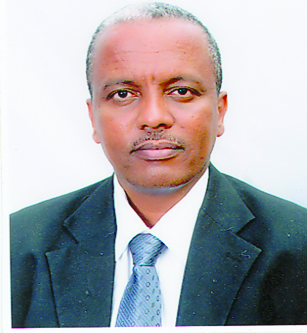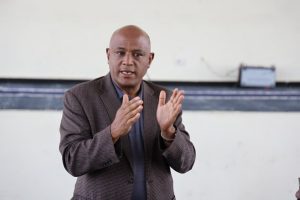
Forestry development and research has long been deprived of due attention and care as it was integrated into the dominant agricultural development sector. To know the reality on the ground, at what level it is right now, recently, The Ethiopian Herald had a stay with Dr. Teshome Tesema, Adviser to the Director General in Ethiopian Environment and Forest Research Institute (EEFRI). He touched up on a range of ideas with regard to forestry development, research green initiative and their association with national green economy in the Horn in general and in Ethiopia in particular.
Enjoy reading!
EH: The institute you are working for in brief
Dr. Teshome: EEFRI is a nationally mandated public research institution whose mission is importing and adapting relevant technologies, conducting and coordinating research in the areas of environment, forestry and climate change, and disseminating suitable technologies and information for end users and stakeholders.
The Ethiopian Herald (EH): It is well known that forest is of paramount importance in keeping nature balance and the economic, social and biodiversity well being. However, Ethiopia’s forest coverage is dwindled to a very minimal percentage from 40 to 45% two decades back. Could you please say something about the present forest coverage status in our country?
Dr. Teshome: Yes, forests are the major components of the natural resources of the planet over in general and of our country in particular. Different documents indicate that a large part of Ethiopia was once extensively covered by diverse and dense forest resources. Some documents claim that in the late nineteenth century, about thirty to forty percent of the country was covered with forests. However, the forest coverage has undergone substantial changes over the years due to innumerable factors. Indiscriminate clearing of the forest for cultivation, cattle grazing, firewood collection and overexploitation without replacement have reduced the great forest areas. The high rate of deforestation and the ruthless exploitation of forest have also resulted in the decline of the forest coverage.
With regard to the present forest coverage, different inventories and assessments of forest resources have been carried out and documented by different institutions. Their estimation of the coverage of forest resources varies due to the respective definition that they have given to a forest. Nowadays a national and official definition has been given for a forest. For a forest to be registered as a forest, it should have an area of ≥ 0.5 ha, height ≥ 2m, Canopy cover
≥ 20%, (MEFCC, Feb. 2015). According to MEFCC, 2016, (the then Ministry of Environment, Forest and Climate Change), the forest cover of Ethiopia was 15.5%. This includes natural forests, plantation forests, wood lands, and bamboo forests. Now, we are in 2020, we need to ask the updated information from Environment, Forest and Climate Change Commission (EFCCC), the currently responsible institution for such data. What I know is EFCCC was working to make the forest coverage 20% by 2020.
EH: It is well known that forest is of paramount importance in keeping nature balance and the economic, social and biodiversity well being. Hence, at what level is it (Forestry development and research undertaking) in Ethiopia right now?
Dr. Teshome: Yes, trees and forests contribute in many ways a wealth of products and services that may be used to improve the well-being of the society. Trees and forests besides their direct contribution to the national economy through wood and non-wood products, they contribute significantly to various sectors of the national economy such as energy, agriculture, food, industry, health, environment, tourism and the likes. They are critical to the welfare of the environment, economy, and population and have multiple values the large portion of which cannot be provided by other kinds of land use. They are sources of food, feed, fuel, construction and industrial wood, gums, resins, medicine and livelihood to millions of people and sequester carbon thereby contributing
to adaptation and mitigation of climate change. They help combat land degradation and desertification as well as rehabilitation of degraded lands and can serve as stewards to greatly minimize the risks of silting up of hydroelectric dams. Forests, indeed, have a significant contribution to food security, poverty reduction, and to the on-going effort to assure economic growth and social transformation.
In order for the society to benefit from the above mentioned attributes of trees and forests, the government has formulated different policies and strategies that could help and guide the actions on the ground. The Climate Resilient Green Economy (CRGE) strategy, the forest policy, forest proclamation, biodiversity policy, and the environment policy are some of the policies and strategies that have been formulated and being implemented. Accordingly, the government based on the above mentioned policies, in collaboration with different actors (NGOs, civic societies, CBOs, private sector, etc.) and through its respective federal and regional institutions has been planning and implementing different research and development activities.
As indicated above, our institute (EEFRI) is a federal research institution responsible for importing and adapting relevant technologies, conducting and coordinating research in the areas of environment, forestry and climate change, as well as disseminating suitable technologies and information for end users and stakeholders. Nursery management and propagation techniques, development and management
of commercial and smallholder plantations, urban forest development and management, species selection, tree improvement and domestication, introduction and expansion of different agro-forestry practices, rehabilitation and restoration of degraded lands are some of the major research thematic areas that have been given prior attention as far as plantation and agro-forestry research is concerned. Accordingly, since its establishment, the institute has been conducted different research projects, generated a number of technologies, knowledge and information in the above mentioned thematic areas and promoted and disseminated them to relevant stakeholders and end users in the form of publications, workshops and demonstrations.
The forest development and management activity is being taken care of by the federal EFCCC and the respective regional bureaus. They carry out nursery establishment and management, seedling production
and distribution, training of farmers and stakeholders, establishment of Participatory Forest Management (PFM) groups, forest management, forest inventory, enforcement of forest rules and regulations and other related activities.
While the forest sector is trying to contribute to the national economic, social and environmental goals in one hand, it is struggling with various challenges like lack of proper organizational structure at different levels on the other hand. Although there are forest policies and strategies in place, the forest sector couldn’t ensure a proper institutional set up that can accomplish those objectives indicated in the policies and strategies. As we move down ward from federal to Kebele levels, we will miss the responsible government entity for forestry. The very low institutional profile of forestry at different levels is the root cause for different problems in the forest sector. This situation needs to be given due attention if we are to bring about a meaningful change in various aspects as forest development can be a basis for myriads of sectors.
Forest development can be a source of everything
EH: The sole effort of the government with regard to rejuvenating forestry development and putting green initiative into practice doesn’t make a difference, obvious. In what way can you elucidate the level of private investment and green economy actors along this line in Ethiopia? Are there prime actors, perhaps, actors involving in this colossal deed? Name them.
Dr. Teshome: Involvement of the private sector in forest development and management is encouraging although it is not as demanded and significant. Lack of incentives, credit schemes, training opportunities and land for planting are some of the major problems that contribute to lower level of participation of private investors. The existing licensing procedural mechanism for investment on forestry is also unnecessarily long and discouraging. However, the government has prepared a national forest investment plan and continued to encourage the private investors to properly contribute to the sector. If this is so, the country will have ample opportunity to well develop its natural resource and in turn exploit the benefits that follow.
EH: Forestry development is increasingly becoming a global agenda; can you say something about the east African engagement in general and that of Ethiopia in particular to hit region’s set target on the subject under discussion? In simple terms, at what level is Ethiopia’s collaboration with the east African states (particularly organizations working on the area) to reinforce the engagement with a view to augmenting region growth and prosperity?
Dr. Teshome: There are various international partnerships and collaborations including with East African Countries in the area
of forestry research and development. For example, EEFRI is working together with KEFRI (Kenyan Forest Research Institute) in various ways including importation of germplasms for forestry research purpose. We are also working with the AFF (African Forest Forum) whose headquarter is in Nairobi. Bio-energy and bamboo are some of the focus areas on which we are collaborating with African countries. The
Great Green Wall of the Sahel and the Sahara Initiative (GGWSSI) is also another area of cooperation. Ethiopia is aggressively working on the area to come up with a difference in all aspects especially on the area under discussion taking EEFRI to the forefront.
EH: Would you place any degree for the tie among national green economy, economic progress and forestry development?
Dr. Teshome: The Climate Resilient Green Economy (CRGE) strategy is the basic strategic document on which other national economic, social and environmental initiatives are based. Economic development projects are expected to be green through reduction of Green House Gas (GHG) emissions and the development of a green economy will be based on four pillars:
The first one is developing green economy: This entails the adoption of agricultural and land use efficiency measure. The second point is about increased GHG sequestration in forestry, i.e., protecting and re-establishing of forests for their economic and ecosystem services including as carbon stocks. The third one is deployment of renewable and clean power generation and the last is exhibiting the use of appropriate advanced technologies in industry, transport, and buildings.
EH: The government of Ethiopia has officially declared to plant close to 5 billion tree seedlings this summer. What is your organization’s contribution to this Grand National Initiative? As a specialist in the area, how could the country make this plan real? Comment on the role scientists of the area like you, government itself, and the general society can play in this regard (put genre by genre fashion, if possible).
Dr. Teshome: EEFRI is contributing, will contribute, a lot to the Green Legacy (tree planting campaign) and other related circumstances through: distribution of
quality seeds and seedlings, delivery and provision of research outputs on forestry (technology and information), participating in the Green Legacy National Committee, provision of training and consultancy services on forestry and conducting its own annual planting on its own selected sites. For our tree planting to be effective and successful, our tree planting campaign needs to be based on knowledge and information and the task requires serious commitment until the trees we plant met its objectives. There should be strong monitoring and evaluation for the trees we planted and we need to strictly follow scientific procedures for pre-planting and post-planting phases of the tree planting campaign.
EH: What should, do you think, be done to recuperate Ethiopia’s forest coverage to the status it was years ago?
Dr.Teshome: The growing attention of the government towards environment, forestry, and climate change and the recognition of the environmental and supportive functions of the forestry sector to other sectors is really a very good opportunity for tree planting, re-greening and forest development. Our country is endowed with diverse agro-ecologies which positioned it to be the best place in the horn of Africa for tree planting and growing various types of tree species for producing wood products and environmental services. We need to exploit this advantage.
In sum, the government at it drives the wheel well, community at all walks of life and even at individual level should move in unison to nurture forests and plant trees with a view to consolidating innovations and improving their impact on sustainable forest resources and well intensifying the conservation of Ethiopia’s bio-diversity. The development of broad policy reformulation and reinforcement, training packages along with local public participation will potentially help the country make a difference.
The Ethiopian Herald June 21/2020
BY MENGESHA AMARE





